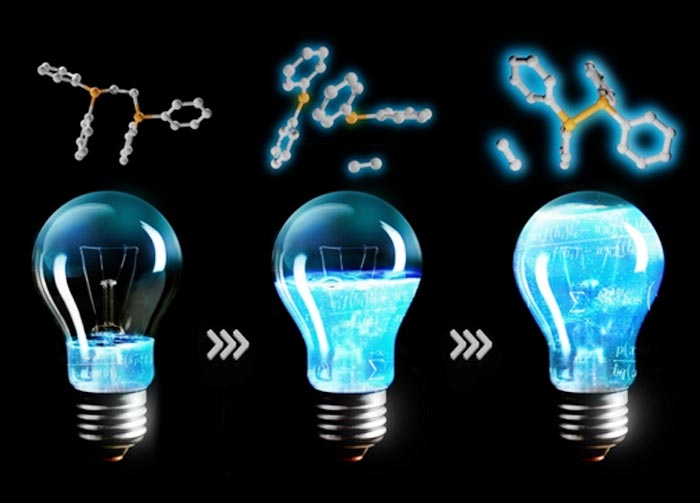Simplified process shines light on new catalyst opportunities

Depiction of the computational process predicting starting materials for the synthesis of DPPE derivatives aided by blue light irradiation. (Hideaki Takano, et al. Nature Communications. November 21, 2022)
Theory-guided development of an easier, more versatile process for synthesizing unsymmetric ligands provides new avenues of exploration in transitional metal catalysis.
Researchers at the Institute for Chemical Reaction Design and Discovery (WPI-ICReDD) have discovered the key to synthesizing a molecular tool that could greatly expand the variety of catalytic reactions possible with transition metals. The team has taken a well-established set of compounds that can be used to make transition metal catalysts and developed a simple, radical-based reaction for creating unsymmetric variants of these molecules using mild conditions. Easier access to a wider variety of these unsymmetric compounds opens a realm of new possibilities for designing transition metal catalysts.
The focus of this research is on a class of compounds called 1,2-bis(diphenylphosphino)ethane derivatives (DPPEs). DPPEs are bidentate — i.e., they attach to the metal center of a catalyst in two locations. However, DPPEs have typically been symmetric, with each attachment arm being the same, which limits the possible structural variety and reactivity. This study overcomes that limit, reporting a versatile method for developing unsymmetric DPPEs using ethylene, an abundantly available feedstock chemical.
To guide their efforts, researchers initially performed quantum chemical computations via the artificial force induced reaction (AFIR) method to identify possible starting materials that could react to form DPPE. Computations showed a viable process whereby phosphine radicals reacted readily with ethylene to form DPPE. Based on this, the team experimentally verified a straightforward process for making symmetric DPPEs that forms phosphine radicals in solution simply by mixing three readily available compounds. This significantly improves upon previous methods that involved multiple steps and the use of unstable, highly reactive compounds.
This process was then extended to unsymmetric DPPEs, mixing ethylene with both chlorophosphines and phosphine oxides that covered a wide range of electronic properties and sizes. The difference in sizes and electronic properties creates a push-pull effect that could lead to beneficial reactivity or selectivity. Optimization studies found the use of a photocatalyst with blue LED irradiation provided the best yield.
As a test, the team then formed metal complexes using one of the unsymmetric DPPE derivatives. They compared the properties of palladium complexed with DPPE and with the unsymmetric DPPE derivative. The two complexes had significantly different properties, including color, absorption spectrum and molecular orbital energy, showing the potential for unsymmetric DPPE derivatives to enable different reactivity when used as ligands in catalysts. Researchers see both the application to catalyst design and the use of a low-cost, abundant material as advantages of this method.
“We succeeded in synthesizing DPPE derivatives that are useful as ligands for transition metal catalysts, and we did this using cheap, readily-available ethylene,” said lead author Hideaki Takano. “This result was realized due to the synergistic effect of using AFIR quantum chemical computations combined with the experimental skill and experience of organic chemists. Moving forward, I would like to develop new, revolutionary reactions using novel ligands synthesized by the method we reported here.”
Journal: Nature Communications
DOI: 10.1038/s41467-022-34546-5
Method of Research: Experimental study
Subject of Research: Not applicable
Article Title: A theory-driven synthesis of symmetric and unsymmetric 1,2-bis(diphenylphosphino)ethane analogues via radical difunctionalization of ethylene
Article Publication Date: 21-Nov-2022
Media Contacts
Sohail Keegan Pinto
Hokkaido University
en-press@general.hokudai.ac.jp
Office: +81-11-706-2186
@HokkaidoUni
Collin Stecker
Institute for Chemical Reaction Design and Discovery, Hokkaido University
public_relations@icredd.hokudai.ac.jp
Office: +81-11-706-9646
@ICReDDConnect
All latest news from the category: Process Engineering
This special field revolves around processes for modifying material properties (milling, cooling), composition (filtration, distillation) and type (oxidation, hydration).
Valuable information is available on a broad range of technologies including material separation, laser processes, measuring techniques and robot engineering in addition to testing methods and coating and materials analysis processes.
Newest articles
Faster, more energy-efficient way to manufacture an industrially important chemical
Zirconium combined with silicon nitride enhances the conversion of propane — present in natural gas — needed to create in-demand plastic, polypropylene. Polypropylene is a common type of plastic found…

Energy planning in Ghana as a role model for the world
Improving the resilience of energy systems in the Global South. What criteria should we use to better plan for resilient energy systems? How do socio-economic, technical and climate change related…

Artificial blood vessels could improve heart bypass outcomes
Artificial blood vessels could improve heart bypass outcomes. 3D-printed blood vessels, which closely mimic the properties of human veins, could transform the treatment of cardiovascular diseases. Strong, flexible, gel-like tubes…





















